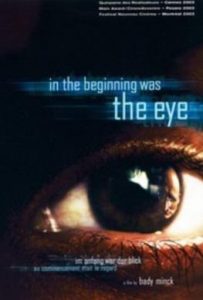A Film by Bady Minck : Unclassifiable.
No other adjective fits this little and delicious essay on Alpine landscapes and tourists that rest thereabout from the year‘s commotion. Bady Minck works with disposable material — old pictures and postcards — and builds with it a monument to touristic kitsch, using all digital technology available as if it were a rejuvenating system for memories. The result is hypnotic and absurdly beautiful, at the same time as it reveals to us that towns and cities also have a soul. (Buenos Aires Festival Internacional de Cine Independiente 04/04) This film takes us on a time-travel using images of an iconic mountain found on postcards. The historic imprint of political realities and human fates are rendered visible onto the idealized landscapes. The post cards where written by travellers who witnessed the same place at different times. (Fly Stories /Chiang-Mai, Thailand 2005)
In the Beginning was the Eye is in an Interdisciplinary Analysis. Manufactured in a melting pot between science and art, Bady Minck’s award-winning film
In the Beginning was the Eye continues its passionate journey in the shape of a book.
The sustainability researcher Heidi Dumreicher and the film author Olaf Möller have gathered fifteen writers who reframe and reiterate the questions posed by the film. What is landscape? A Garden of Eden, a data base, a cinematic backdrop? How does film respond to landscape, science to film, and landscape to science? What is the role of time, velocity, animation, philosophy, and fine arts in this process?
In the Beginning was the Eye is with its 45 minutes of abundant avant-garde research, the figurehead of the Director’s Fortnight in Cannes 2003. At times a dreamlike vision, at times political, philosophical and even culinary, the film is technically perfect. The stunning sound and visuals and the hypnotic editing ensure you not to get bored for a second. (Martin Granica, Repérages, Paris)
Like the film, the book traverses the boundaries between ecology, science, art, and film, in the process reconnecting numerous facets which were articulated cinematographically by the film and discussed at the
cinESCAPE symposium.
Film, symposium, and book are the result of a long lasting and fruitful cooperation between Amour Fou Film production Vienna, Minotaurus Film Luxembourg and the research institute Oikodrom. Interdisciplinary analyses, comments and essays as well as collages by the filmmaker give insight into the development, history, are the background of In the Beginning was the Eye.
Interdisciplinary analysis, comments and essays as well as collages by the filmmaker give insight into the development, history, and background of In the Beginning was the Eye .
In terms of the interaction of science and art, the contributors of the book include scientists, film critics, filmmakers and poets.
In the Beginning was the Eye participates in a typically Austrian massacre play but sets itself apart through the strength of its talent and focus. Armed with an avalanche of postcards, the film delves deep into a world of clichés, revealing the horrors the picture-perfect surfaces conceal. (Jean-Philippe Tessé/Cahiers du cinéma, Paris)
The Bady Minck‘s avant-garde film breaks through the conservative norms of documentary filmmaking. The film reexamines a world of banal images on thousands of landscape postcards that depict the Austrian Alps and the Salzburg province. A film that surprises both the eye and the mind at every turn — it‘s about memory, language and the senses that deceive us.
In the Beginning was the Eye is the »Alice Through the Looking Glass« of documentary avant-garde films, which will leave you overwhelmed. (Doc Aviv/Tel Aviv Documentary Film Festival).
2003 has turned out to be a particularly strong year for Austria, which has a national record five films in varying parts of the Festival de Cannes. The Bady Minck‘s documentary is looking to be especially intriguing.
In the Beginning Was the Eye is an avant-garde exercise using thousands of Alpine view postcards. (Kenneth Turan/ Los Angeles Times 05/2003)M
45 min, colour 35 mm, 1:1.66
Dolby Digital German and 7 other languages
(English/ French subtitles)
Drehbuch und Richtung: Bady Minck
Project Lead and Scientific Berater : Heidi Dumreicher
Musik: Bernhard Fleischmann, Dr. Nachtstrom, Sainkho Namtchylak
Gedichte und Stimmen: Bodo Hell, Friederike Mayröcker, Ernst Jandl
Kamera: Jerzy Palacz, Martin Putz, Martin Gschlacht
Schnitt: Frederic Fichefe, t Anne Schroeder
Ton: Carlo Thoss, Frederic Fichefet,
Visuelle Post-Produktion: Martin Putz,
Darsteller: Bodo Hell
Produzent: Alexander Dumreicher- Ivanceanu
Produktion: Minotaurus Film Luxemburg, OikodromWien, Garabet FilmWien, Amour FouWien
Vertrieb in Österreich:Polyfilm Internationaler Vertrieb und Verkauf: Sixpack Film
International Distribution: Light Cone
Weltvertrieb: Autlook Filmsales Erhältlich auf DVD

